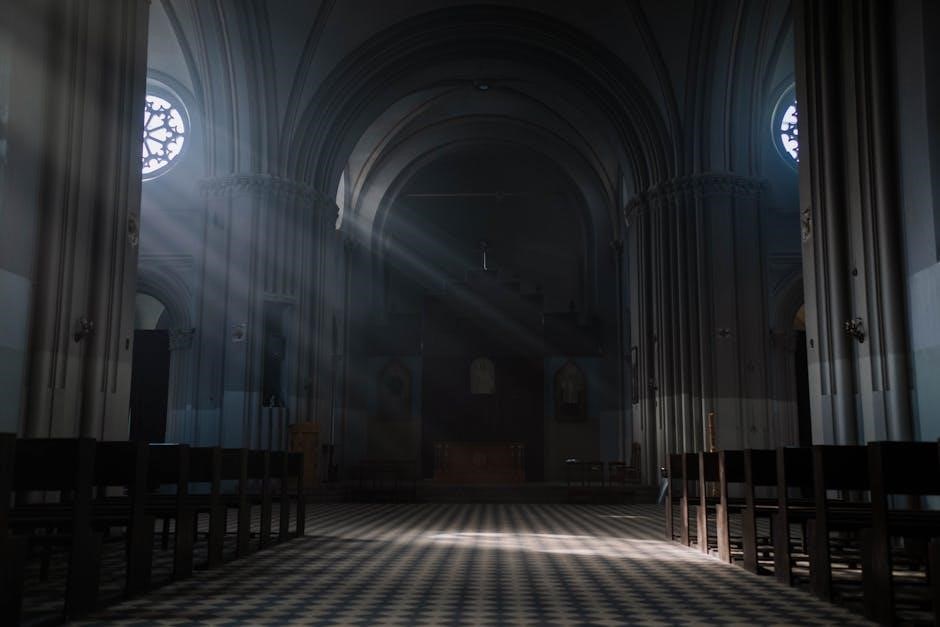Without Sanctuary: Lynching Photography in America is a haunting collection edited by James Allen‚ featuring 98 graphic images of lynching‚ with essays by John Lewis‚ Leon F. Litwack‚ and Hilton Als‚ published in 2000.
Overview of the Book
Without Sanctuary: Lynching Photography in America is a profound and unsettling collection of 98 lynching photographs compiled by collector James Allen. The book‚ published in 2000 by Twin Palms Publishers‚ includes essays by prominent figures such as Congressman John Lewis‚ Leon F. Litwack‚ and Hilton Als. It documents the brutal practice of lynching in America‚ offering a visual testament to the racial violence inflicted upon African Americans. The photographs‚ often taken as grotesque souvenirs‚ expose the horrifying reality of white supremacy and its manifestations. This book serves as a critical historical record‚ urging readers to confront and understand this dark chapter of American history.
Historical Context of Lynching in America
Lynching in America was a brutal tool of racial terror‚ predominantly targeting African Americans from the late 19th to the mid-20th century. It was rooted in white supremacy and used to enforce social control and racial hierarchy. The Tuskegee Institute recorded over 3‚400 lynchings between 1882 and 1950. These acts were often public spectacles‚ with photographs taken as disturbing mementos. Without Sanctuary captures this harrowing history‚ revealing the systemic violence and terrorism faced by African Americans. The book highlights how lynching was not just murder but a method to instill fear and maintain racial oppression‚ leaving a lasting scar on American society.
The Role of Photography in Documenting Lynching
Photography played a pivotal role in documenting the atrocities of lynching in America‚ serving as both a tool of perpetuation and a means of exposure. Many lynching photographs were taken as grotesque souvenirs‚ distributed as postcards to celebrate racial violence. These images‚ now compiled in Without Sanctuary‚ reveal the brutal reality of racial terrorism. They capture the collective cruelty of perpetrators and the dehumanization of victims. While these photographs were initially used to spread fear‚ they later became vital evidence of America’s violent past‚ forcing a confrontation with its history and fostering dialogue about race and justice.

Contributors to the Book
James Allen edited and collected the images‚ while Congressman John Lewis‚ Leon F. Litwack‚ and Hilton Als provided powerful essays‚ adding historical and emotional context to the photographs.
James Allen: Collector and Editor
James Allen‚ an American antique collector‚ dedicated over 45 years to gathering lynching photographs and postcards‚ exposing a dark chapter of racial violence in America. His meticulous collection‚ featured in Without Sanctuary‚ includes nearly 100 harrowing images‚ many from the early 20th century. Allen’s work not only preserves these historical artifacts but also confronts the brutality of lynching‚ serving as a stark reminder of the terrorism faced by African Americans. His role as editor ensures these visual testimonies are presented with the gravity they deserve‚ complemented by essays from prominent figures like Congressman John Lewis and historian Leon F. Litwack.

Congressman John Lewis: Foreword
Congressman John Lewis contributes a powerful foreword to Without Sanctuary‚ emphasizing the necessity of confronting America’s violent past. He describes the photographs as a testament to the “American holocaust‚” underscoring the brutal reality of racial terrorism. Lewis‚ a civil rights icon‚ connects the historical atrocities to the ongoing struggle for justice‚ urging readers to acknowledge the pain inflicted on African Americans. His words add moral weight to the book‚ framing it as a vital tool for understanding and confronting the legacy of lynching in America. His foreword is a call to action‚ ensuring these horrors are not forgotten.
Leon F. Litwack’s introduction to Without Sanctuary provides historical context to the grotesque practice of lynching‚ framing it as a tool of racial control. A Pulitzer Prize-winning historian‚ Litwack examines the psychological and social dynamics that allowed such violence to persist‚ highlighting the complicity of white society. His analysis situates the photographs within America’s broader narrative of racial oppression‚ emphasizing their role as evidence of a dark chapter in the nation’s history. Litwack’s words bridge the past and present‚ reminding readers that these images are not just artifacts but a mirror reflecting America’s unresolved racial tensions and collective guilt.
Hilton Als: Essay Contributions
Hilton Als‚ a renowned critic and essayist‚ contributes poignant and incisive essays to Without Sanctuary‚ offering a literary and cultural perspective on the horrors of lynching. His writing underscores the psychological and emotional toll of racial violence‚ weaving personal reflections with historical analysis. Als’s essays complement the graphic imagery‚ providing a voice to the silenced victims and challenging readers to confront the moral and ethical implications of these atrocities. His contributions elevate the book beyond a visual archive‚ transforming it into a powerful narrative that demands reckoning with America’s troubled past and its enduring impact on contemporary society.

Visual Documentation in “Without Sanctuary”
James Allen’s collection includes 98 harrowing images of lynching‚ captured as souvenirs‚ providing a brutal visual record of racial violence and terrorism in America.
Origins of Lynching Photographs
The origins of lynching photographs stem from the late 19th and early 20th centuries‚ often taken by amateur photographers or professionals as gruesome souvenirs. These images were frequently distributed as postcards‚ celebrating racial violence and reinforcing white supremacy. Many were later collected by James Allen‚ who spent decades gathering these disturbing visuals‚ uncovering a dark chapter in American history. The photographs serve as chilling evidence of the terrorism inflicted upon African Americans‚ capturing the brutality and normalizing it within societal norms. They remain a powerful‚ albeit horrific‚ testament to the atrocities committed during this period.
The Collection of James Allen
James Allen spent over 45 years compiling a remarkable collection of lynching photographs and postcards‚ uncovering a visual legacy of racial violence in America. His efforts resulted in the publication of Without Sanctuary‚ which includes nearly 100 harrowing images. These photographs‚ often graphic and deeply unsettling‚ were originally taken as morbid souvenirs by participants or witnesses. Allen’s collection not only preserves these historical artifacts but also confronts the brutality of lynching‚ providing a stark reminder of America’s troubled past. His work has been instrumental in raising awareness about the atrocities committed against African Americans during the late 19th and early 20th centuries.
Postcards as Souvenirs of Lynching
Lynching postcards‚ included in James Allen’s Without Sanctuary‚ reveal a disturbing practice where such events were commemorated as souvenirs. These postcards‚ often inscribed with racist remarks‚ were mailed to friends and family‚ normalizing racial violence. They served as tools of intimidation‚ spreading fear within African American communities and reinforcing white supremacy. The images and captions on these postcards provide chilling insights into the societal attitudes that condoned lynching. By preserving these artifacts‚ Allen’s collection exposes the brutality and inhumanity of this practice‚ ensuring that such atrocities are not forgotten or sanitized in historical memory.
Specific Cases Documented in the Book
Without Sanctuary details specific lynching cases‚ such as the 1911 murders of Laura and L.D. Nelson in Oklahoma‚ captured in gruesome photographs. These images‚ along with postcards and descriptions‚ provide harrowing details of individual atrocities. The book documents numerous cases‚ preserving the identities of victims and exposing the brutality of racial violence. These cases highlight the systematic nature of lynching‚ offering a poignant reminder of America’s dark past. By presenting these specific incidents‚ the book ensures that the victims’ stories are not forgotten‚ serving as a testament to the horrors of racial terrorism.

Themes and Essays in the Book
Without Sanctuary explores themes of racial violence‚ white supremacy‚ and societal complicity. Essays by John Lewis‚ Leon Litwack‚ and Hilton Als provide powerful perspectives on these atrocities‚ offering historical context and emotional depth. The book examines the psychological impact of lynching on communities and the moral failure of a society that allowed such violence. These essays underscore the enduring relevance of confronting America’s past to understand its present and future. The contributors’ voices add layers of reflection‚ ensuring the book is both a historical record and a call for reckoning.
Racial Violence and White Supremacy
Without Sanctuary vividly documents the brutal reality of racial violence in America‚ exposing the systemic white supremacy that fueled lynching. The graphic images and essays reveal how these atrocities were tools of terror‚ intended to subjugate African Americans. Postcards of lynchings‚ often kept as souvenirs‚ highlight the normalization of violence within white communities. Contributors like John Lewis and Leon Litwack emphasize how such acts were not isolated but part of a broader culture of domination. The book serves as a stark reminder of the deep-seated racism that shaped American history‚ urging readers to confront the horrors of the past to understand the present.
The Psychological Impact of Lynching
Without Sanctuary explores the profound psychological toll of lynching on African American communities‚ creating a climate of fear and trauma. Survivors and witnesses faced lifelong emotional scars‚ while the broader community endured collective trauma. Essays by Hilton Als and Leon F. Litwack highlight how these atrocities embedded racial terror into the psyche of America. The graphic images serve as a visual testament to the psychological warfare waged through violence. This psychological impact persists‚ influencing contemporary race relations and societal dynamics‚ as the book seeks to confront and heal these historical wounds through exposure and education.
Societal Reactions to Lynching Practices
Without Sanctuary reveals the shocking societal acceptance and complicity in lynching‚ a tool of racial terror. Many white Americans witnessed or supported these acts‚ while others remained silent‚ perpetuating a culture of fear. The book highlights how lynching postcards became grotesque souvenirs‚ normalizing violence. Conversely‚ activists and intellectuals like W.E.B. Du Bois and Ida B. Wells courageously denounced lynching‚ sparking resistance. Essays by Hilton Als and Leon F. Litwack examine how societal indifference enabled racial violence‚ while John Lewis’s foreword underscores the moral obligation to confront this history. The book exposes the duality of societal reactions‚ from complicity to resistance‚ urging accountability and change.
Modern Relevance of Historical Atrocities
Without Sanctuary underscores the enduring impact of lynching on contemporary race relations. By documenting these atrocities‚ the book bridges the past and present‚ revealing how historical violence shapes modern societal inequities. The graphic imagery and essays serve as a stark reminder of the legacy of white supremacy‚ urging ongoing dialogue about racial justice. The book’s modern relevance lies in its ability to educate new generations‚ fostering empathy and understanding. It challenges society to confront uncomfortable truths‚ ensuring that the horrors of lynching are not forgotten but learned from. This collection remains a vital tool for addressing systemic racism and promoting healing.

Exhibitions and Legacy of “Without Sanctuary”
Without Sanctuary has been exhibited in seven venues‚ sparking intense public response and raising awareness about racial violence; Its legacy endures as a powerful educational tool‚ ensuring historical atrocities are remembered and their impact on modern society understood.
Exhibition History and Public Response
Without Sanctuary was first exhibited in 2000‚ showcasing its harrowing lynching photographs. The public response was intense‚ with reactions ranging from shock to profound reflection. The graphic images provoked visceral emotions‚ sparking debates about America’s racial history. Many found the exhibition a necessary confrontation of past atrocities‚ while others criticized its graphic nature. Despite controversy‚ the exhibit achieved its goal of raising awareness about racial violence‚ fostering dialogue about justice and equality. The photographs‚ though disturbing‚ served as a powerful educational tool‚ ensuring that the horrors of lynching are not forgotten. The exhibit remains a significant cultural and historical milestone.
Without Sanctuary significantly heightened awareness of racial violence by exposing the brutal reality of lynching through its graphic imagery. The book and exhibition forced America to confront its dark past‚ revealing the terrorism faced by African Americans. By presenting visual evidence‚ it challenged denial and complacency‚ making it impossible to ignore the atrocities. This exposure sparked conversations about systemic racism and the need for justice. The project became a catalyst for educational initiatives and racial dialogue‚ ensuring that the horrors of lynching remain part of the national consciousness‚ urging reconciliation and change. Its impact continues to resonate in contemporary discussions of race and equality. Without Sanctuary holds profound cultural significance as a visual record of America’s racial atrocities. The book serves as a testament to the nation’s violent past‚ preserving memories that might otherwise be forgotten. By confronting the brutality of lynching‚ it challenges historical amnesia and fosters a deeper understanding of the legacy of white supremacy. The inclusion of essays by prominent figures like John Lewis and Hilton Als adds depth‚ contextualizing the images within broader social and historical frameworks. This work is not just a historical document but a tool for education and reflection‚ urging society to confront its past and pursue justice and equality. Its cultural importance lies in its ability to provoke necessary conversations about race and humanity. Without Sanctuary has received significant academic acclaim for its unflinching portrayal of racial violence in America. Scholars praise its historical significance‚ with Leon F. Litwack describing it as a “visual legacy” of lynching. The book is recognized for its role in preserving a brutal chapter of American history‚ offering a powerful educational tool. However‚ its graphic content has sparked debates about the ethics of displaying such imagery. Despite these controversies‚ the work remains a vital resource for understanding the terror inflicted on African Americans. Its academic impact is undeniable‚ as it continues to influence studies on race‚ violence‚ and historical memory. Without Sanctuary serves as a powerful educational tool‚ using lynching photographs and essays to raise awareness about America’s history of racial violence and its enduring impact on society. Photography in Without Sanctuary is a poignant educational tool‚ exposing the brutal reality of lynching in America. These images‚ though graphic‚ provide a visual record of racial violence‚ forcing confrontation with a painful history. By preserving these photographs‚ James Allen ensures they serve as a historical testament‚ educating future generations about the atrocities committed against African Americans. The book challenges society to acknowledge and learn from these crimes‚ fostering a deeper understanding of systemic racism and its legacy; This visual documentation is essential for teaching tolerance and promoting racial justice‚ making it a vital resource for educators and historians. Integrating Without Sanctuary into school curricula is crucial for understanding America’s racial history. The book’s graphic content necessitates careful handling‚ ensuring it is presented in an age-appropriate manner. Educators can use the images and essays to explore themes of racial violence‚ injustice‚ and resilience‚ fostering empathy and critical thinking. By examining lynching’s historical context‚ students gain insights into its role in perpetuating white supremacy and its enduring impact on society. This approach not only educates but also encourages students to reflect on contemporary issues of racism and equality‚ promoting a more informed and compassionate future generation. Without Sanctuary serves as a vital tool for preserving the historical memory of lynching in America. By documenting these atrocities through photographs and essays‚ the book ensures that such events are not forgotten or sanitized. The collection‚ meticulously gathered by James Allen‚ provides a visceral reminder of the violence endured by African Americans‚ countering attempts to erase or downplay this dark chapter of history. The book’s graphic content forces confrontations with the past‚ fostering a deeper understanding of racial violence and its legacy. It stands as a testament to the importance of preserving difficult truths for future generations to learn from and reflect upon. Discussing racial violence‚ as depicted in Without Sanctuary‚ presents significant challenges due to its graphic and disturbing nature. The book’s images of lynching force a confrontation with America’s brutal past‚ often leading to discomfort and resistance. Many struggle to acknowledge the scale and cruelty of these atrocities‚ as they contradict narratives of a more harmonious history. Educators and readers must navigate these sensitivities while ensuring the truth is not diluted. The emotional and psychological impact of such content necessitates careful handling‚ balancing historical accuracy with empathy for the victims and their descendants. This makes fostering open‚ honest dialogue particularly difficult yet essential for true understanding and reconciliation. Without Sanctuary is available in print and digital formats‚ including a widely accessible PDF version. Published by Twin Palms‚ it remains a significant resource for historical study and reflection. Without Sanctuary was first published in 2000 by Twin Palms Publishers‚ with subsequent editions released‚ including a 15th edition in 2021. The book is available in print‚ featuring 98 lynching photographs and essays by prominent contributors. Its ISBN is 0-944-09269-1‚ and it is priced at $60. The print edition is a significant resource for those preferring physical copies‚ offering a tangible experience of this critical historical documentation. Twin Palms Publishers has played a crucial role in ensuring the book’s availability‚ making it accessible for educational and reflective purposes. Digital versions of Without Sanctuary are available‚ including PDF formats‚ allowing readers to access the content electronically. The PDF version is widely sought after for its convenience‚ enabling easy sharing and accessibility. However‚ due to copyright restrictions‚ direct downloading may require authorized platforms or purchases. Various online libraries and retailers offer the PDF for legal download‚ ensuring the book’s critical content reaches a broader audience while respecting intellectual property rights. This digital accessibility has made the book a valuable resource for modern educators‚ researchers‚ and the general public interested in understanding America’s lynching history. The digital version of Without Sanctuary is accessible online through various platforms‚ including libraries and retailers. Readers can access the PDF format by purchasing or borrowing it legally. This availability ensures the book’s critical examination of America’s lynching history reaches a wide audience‚ aiding education and awareness about racial violence. Online access also supports research and academic studies‚ making the book a vital resource for understanding this dark chapter of American history. Its digital presence continues to facilitate dialogue on race and justice‚ ensuring the lessons of the past remain relevant today. Readers can access Without Sanctuary in digital formats‚ including PDF‚ through platforms like Z-Library or purchasing from online retailers. The book is also available for reading online without downloading‚ offering convenience for educational purposes. PDF versions ensure high-quality images and text‚ preserving the book’s historical significance. Additionally‚ e-book formats are compatible with various devices‚ allowing readers to engage with the content anywhere. While some sites may offer free downloads‚ purchasing through official channels supports the authors and publishers. This accessibility makes the book a valuable resource for those studying America’s lynching history and its impact on race relations. Without Sanctuary sparks debate due to its graphic lynching images‚ raising ethical concerns about publishing violent content while balancing historical truth and sensitivity to victims’ families. The publication of Without Sanctuary raises significant ethical dilemmas‚ as it involves sharing deeply disturbing and graphic images of lynching. While the intent is to educate and preserve history‚ critics argue that such content can cause emotional distress‚ particularly to descendants of victims. The images‚ though historical‚ are inherently violent and traumatic‚ leading to debates about the balance between historical truth and respect for the dignity of those depicted. Editors and publishers must consider the impact on affected communities and whether the educational value outweighs the potential harm caused by revisiting these atrocities. Without Sanctuary has sparked both praise and criticism. Supporters argue it serves as a crucial educational tool‚ confronting America’s violent racial past and fostering dialogue about justice and equality. The book is commended for its unflinching portrayal of historical atrocities‚ ensuring they are not forgotten. Critics‚ however‚ highlight the graphic nature of the images‚ expressing concerns about the emotional toll on readers‚ particularly the African American community. Some question the ethicality of publishing such content‚ while others defend it as a necessary confrontation with history. This duality underscores the book’s complex role in public discourse. Without Sanctuary faces the challenge of balancing the raw truths of lynching with sensitivity toward its audience. Editors James Allen and contributors acknowledge the graphic nature of the images‚ emphasizing their historical significance as evidence of racial terrorism. While some critics argue the book risks re-traumatizing communities of color‚ supporters believe it is essential to confront these atrocities to understand their impact on American history. The inclusion of essays by prominent figures like John Lewis and Hilton Als provides context‚ aiming to guide readers through the emotional and ethical complexities of engaging with such disturbing content. This balance is crucial for fostering informed dialogue without exploitation. The publication of Without Sanctuary raises significant legal and moral questions about sharing lynching images. Legally‚ there are concerns about copyright and the rights of victims’ families‚ though many images are in the public domain. Morally‚ the debate centers on whether displaying such graphic content respects the dignity of the victims or perpetuates their exploitation. Editor James Allen and contributors argue that these images serve as crucial historical evidence‚ necessary for understanding racial violence. However‚ critics warn that their dissemination could cause harm or be misused‚ sparking discussions about the ethical responsibilities of archiving and sharing traumatic visual histories. Without Sanctuary significantly contributes to America’s historical record‚ exposing lynching’s brutality and its role in racial oppression. It influenced civil rights movements and sparked contemporary race relations discussions‚ becoming a vital educational tool for understanding racial violence and its legacy in modern society. Without Sanctuary preserves the harrowing visual history of lynching in America‚ documenting over 3‚400 cases recorded by the Tuskegee Institute. Editor James Allen’s collection of lynching photographs and postcards provides irrefutable evidence of racial violence‚ offering a stark reminder of America’s brutal past. The book‚ featuring essays by John Lewis‚ Leon F. Litwack‚ and Hilton Als‚ exposes the terrorism inflicted on African Americans‚ ensuring these atrocities are not erased from historical memory. By publishing these images‚ Without Sanctuary has become a critical resource for understanding racial violence‚ making it an essential contribution to America’s historical record and a powerful educational tool for future generations. Without Sanctuary has profoundly influenced civil rights movements by exposing the brutal reality of lynching in America. Its graphic images and essays‚ including Congressman John Lewis’s foreword‚ have educated audiences about racial violence‚ inspiring advocacy for justice and equality. The book’s unflinching documentation of atrocities has sparked conversations about systemic racism and the need for reform. By humanizing victims and confronting America’s past‚ Without Sanctuary has empowered activists and scholars‚ contributing to ongoing efforts to address racial inequality and promote human rights‚ ensuring its legacy as a pivotal resource in the fight against racial injustice and the pursuit of civil rights. Without Sanctuary continues to resonate in modern race relations by confronting historical injustices and sparking dialogue about systemic racism. Its documentation of lynching atrocities has raised awareness of the enduring impact of racial violence on communities. The book challenges modern society to confront uncomfortable truths‚ fostering empathy and understanding. By preserving these harrowing images‚ it serves as a reminder of the ongoing struggle for racial equality‚ encouraging discussions on police brutality‚ discrimination‚ and social justice. Without Sanctuary remains a vital tool for addressing contemporary race relations‚ emphasizing the importance of acknowledging history to build a more equitable future. Without Sanctuary has left an indelible mark on modern society by preserving the dark history of lynching in America. As a seminal work‚ it has become a critical resource for understanding racial violence and its lasting impact. The book’s unflinching documentation has inspired exhibitions‚ educational programs‚ and discussions on racial justice. Its legacy lies in its ability to confront uncomfortable truths‚ fostering a deeper understanding of America’s past and its connection to contemporary issues. By keeping these atrocities in public memory‚ Without Sanctuary ensures that the lessons of history are not forgotten‚ contributing to ongoing conversations about race‚ justice‚ and equality.Impact on Racial Violence Awareness
Cultural Significance of the Book
Academic Reception and Reviews

Education and Awareness Through the Book
Using Photography as a Tool for Education
Teaching About Lynching in Schools
Preserving Historical Memory
Challenges in Discussing Racial Violence

Availability and Formats of “Without Sanctuary”
Print Editions and Publisher Information
Digital Versions and PDF Availability
Accessibility of the Book Online
Downloading and Reading Options

Controversies and Ethical Considerations
Ethical Dilemmas in Publishing Graphic Content
Criticism and Support for the Book
Balancing Historical Truth with Sensitivity
Legal and Moral Implications of Sharing Lynching Images

Cultural and Historical Impact
Contribution to American Historical Record
Influence on Civil Rights Movements
Impact on Contemporary Race Relations
Legacy of the Book in Modern Society
